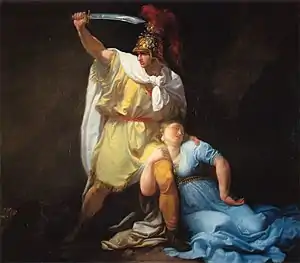| Iberian–Armenian War | |||||||
|---|---|---|---|---|---|---|---|
 Rhadamistus killing Zenobia | |||||||
| |||||||
| Belligerents | |||||||
|
War of 35–36 War of 47 War of 50–51 War of 52–54 |
War of 35–36 Supported by War of 47 War of 50–51 War of 52–54 | ||||||
| Commanders and leaders | |||||||
|
War of 35–36 War of 47 War of 50–51 War of 52–54 |
War of 35–36 War of 47 War of 50–51 War of 52–54 | ||||||
| Part of a series on the |
| History of Georgia |
|---|
.jpg.webp) |
| History of Armenia |
|---|
 Coat of Arms of Armenia |
| Timeline • Origins • Etymology |
The Iberian–Armenian War was a war for the throne of Armenia between the Kingdom of Iberia and the Armenian Arsacids. It is known chiefly through its description in Tacitus 'Annals.
Background
The war took place as a delicate balance of power between the Roman and Parthian empires was in place in the Caucasus. Rome was then ruled by Claudius, Parthia by Vologases I. Two Iberian brothers then ruled the Caucasian kingdoms, Pharasmanes I in Iberia, Mithridates in Armenia. They were both dependent on Roman support, which had installed Mithridates on the Armenian throne in 35 AD.[1] However, 15 years later, trust between the brothers had deteriorated, which Tacitus blames on the intrigues of Pharasmanes' son Rhadamistus.[2]
War of 35–36
Capture of Artaxata
In 35, the Parthian king Artaban II placed his son Arsaces on the Armenian throne, which displeased Rome. Emperor Tiberius turned to Mithridates and invited him to install him as the king of Armenia, provided that the latter recognized the suzerainty of Rome. Mithridates accepted the emperor's offer and in a short time sent a large army led by Pharasmanes to Armenia. Pharasmanes effortlessly took the capital Artaxata, expelled Arsaces from the country and crowned his brother king of Armenia.
Battle between Pharasmanes and Orodes
In response to the actions of the Iberians, Artabanus sent an army to Armenia under the command of Prince Orodes. Pharasmanes, who reinforced his troops with mercenary detachments of Sarmatians and Albanians, immediately moved against the Parthians. The sources do not preserve the name of the place where the troops of the two princes met, however, the vicissitudes and the course of the battle itself are described as follows:
After both troops prepared for battle, the Parthian commander, in a speech to the soldiers, recalled the rule in the East, the glory of the Arsacids, and the fact that their enemy was an unknown Iberian with an army of mercenaries; Pharasmanes said that, not knowing the Parthian yoke over them, the more they strive for, the greater glory the victory will bring them, and if they flee, the more shame and danger they will incur; At the same time, he pointed to the formidable battle formation of his people and to the gilded detachments of the Medes, saying that here are men, there is booty.[3]
The Parthian army consisted mainly of cavalry, while Pharasmanes also had strong infantry. During the battle, the Iberian horseman knocked the Parthian cataphracts to the ground, and the infantrymen finished them off. The outcome of the battle was decided by the clash between the two commanders.
In the midst of the battle, Pharasmanes and Orodes, who fought among the front lines and rushed to the aid of the faltering and therefore were noticeable, recognize each other, they rush with weapons at one another, and Pharasmanes, forestalling the enemy, cut Orode’s helmet and inflicted a wound on him. But, carried forward by his horse, he was unable to repeat the blow, and the bravest of the warriors managed to shield the wounded man; Believing, however, the false news of his death, the Parthians were confused and they lost the battle against the Iberians.[4]
Artabanus' Expulsion
After the defeat of his two sons, Artabanus decided to take personal revenge on Pharasmanes. He gathered a huge army and in 36 invaded Armenia. Pharasmanes skillfully led the defense of the country, imposed on the Parthians a long, exhausting war that was convenient for him, after which the Iberians gradually gained the upper hand. At the same time, the Romans started rumors that they were going to begin a campaign in Mesopotamia. Artabanus was forced to leave Armenia. “With Artabanus leaving Armenia, his power also came to an end.”[5]
War of 47
In 42-47, Mithridates was in Roman captivity, and Armenia was captured by the Parthians. After being released from captivity, Emperor Claudius returned the Armenian crown to Mithridates. In 47, Mithridates invaded Armenia with Roman legions, while at the same time the troops of Pharasmanes moved from the north. Together they defeated the Parthian protege Demonakt, after which Mithridates regained the royal throne. Cotys, the king of Lesser Armenia, also submitted to him
War of 50–51
Iberian invasion of Armenia
Fearing usurpation by Rhadamistus, his father convinced him to make war upon his uncle and claim the Armenian throne for himself. The Iberians invaded with a large army and surrounded Mithridates at the fortress of Gorneas (Garni), which was garrisoned by the Romans under the command of Caelius Pollio, a prefect, and Casperius, a centurion. Rhadamistus took the fortress by assault. Mithridates left the fortress in order to make peace with Rhadamistus. Rhadamistus then executed Mithridates and his sons, despite a promise of non-violence, and became King of Armenia. Of this usurpation, Tacitus wrote "Rhadamistus might retain his ill-gotten gains, as long as he was hated and infamous; for this was more to Rome's interest than for him to have succeeded with glory".[6]
War of 52–54
Parthian invasion of Armenia
Faced with this upset of the regional balance and regarding the event as unrightful appropriation, Vologases I of Parthia invaded in 52 AD to proclaim his brother Tiridates king of Armenia. The Iberians did not offer battle and withdrew from some Armenian cities including Artaxata, for the Parthians to capture them without resistance. The conflict lasted for two years, until winter, plague and shortage of supplies forced Tiridates to retire from Armenia, which allowed Rhadamistus to return with his army strenghtened and reassert rule. However, he would eventualy be deposed due to being oppressive and punishing the populace for what he perceived was treason, when they allowed the Parthians to enter their towns unopposed. The Armenian nobility finally revolted in 55 AD and attempted to apprehend Rhadamistus in his palace, but he managed to escape togheter with his spouse Zenobia. When Thiridates returned the same year, he was declared king of Armenia instead.[7] However Parthian control over Armenia was unacceptable to Rome and soon after, the dispute escalated into the Roman–Parthian War of 58–63.
References
Sources
Tacitus. Annals. Book XII, Chapters 44-51. Retrieved December 15, 2023.
Toumanoff, Cyril (1969), Chronology of the early Kings of Iberia, Vol. 25
Grousset, R. (1947). Histoire de l'Arménie des Origines à 1071 [History of Armenia from its origins to 1071] (in French). Paris: Payot.